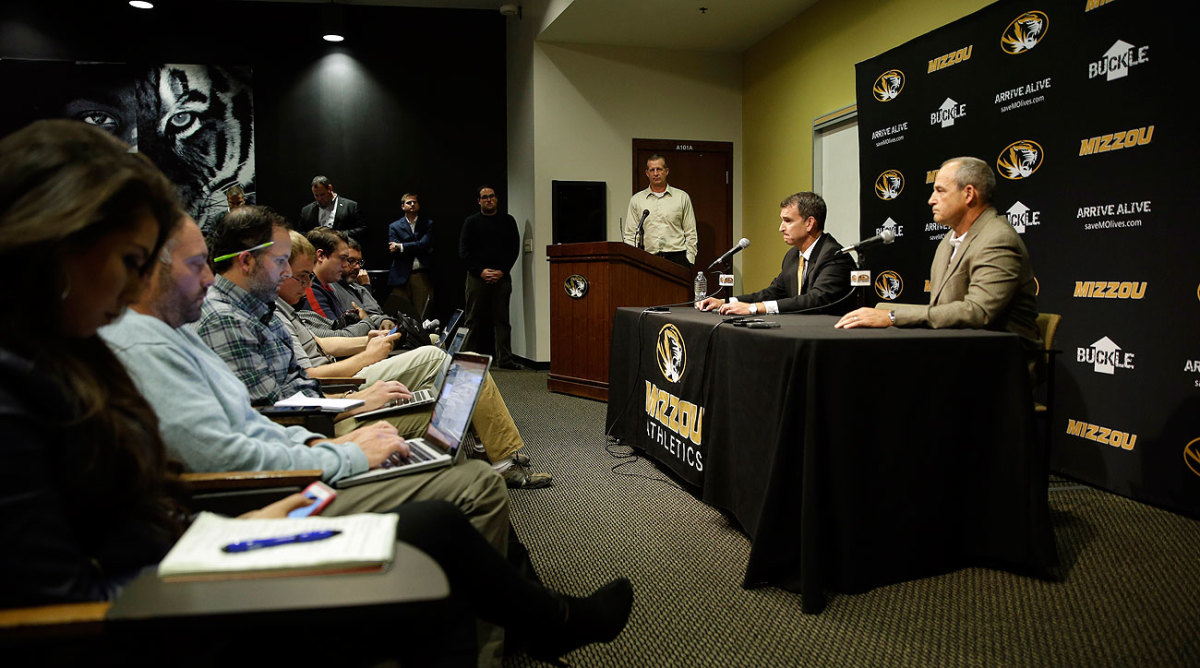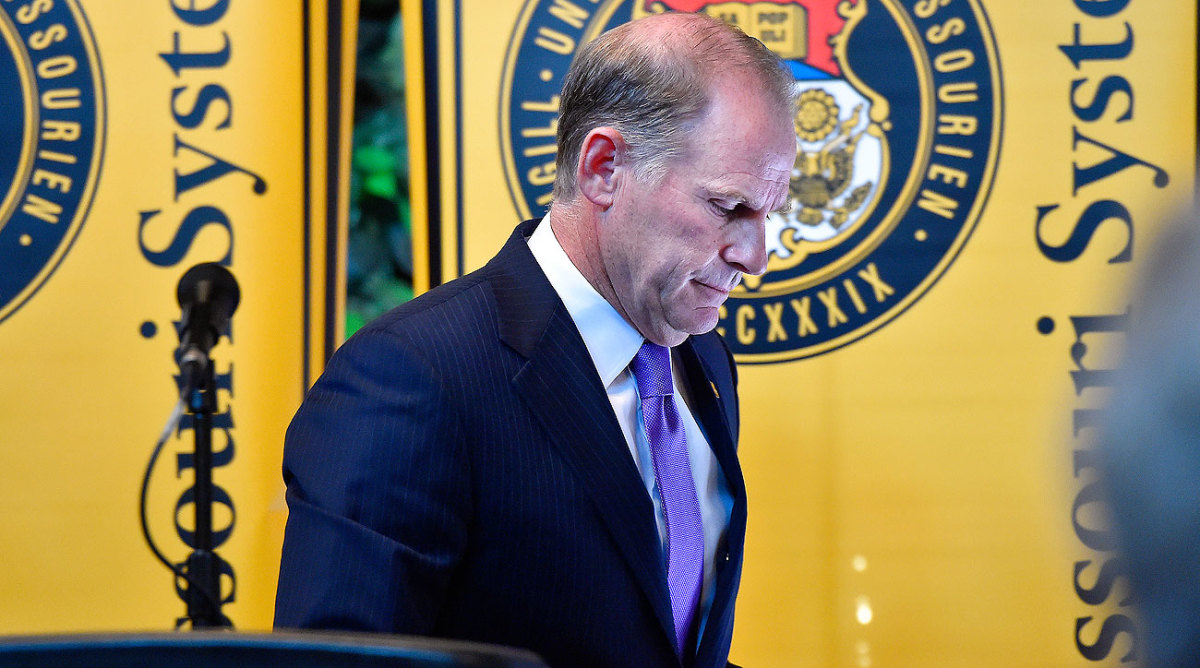The Message of Missouri

COLUMBIA, Mo. — While news spread that Tim Wolfe had resigned his post as University of Missouri president, the football players who had catapulted this smoldering campus issue into a national news frenzy stood quietly off to the side of the celebration, removed from the cluster of tents on Carnahan Quad, where a graduate student had been living for eight days while on a hunger strike seeking Wolfe’s ouster.
The football players took pictures on their smartphones, mostly refused comment and grinned at the sight. Michael Sam stood with them, documenting the moment on his phone.
“None of this s--- happens without the football team,” said Sam, a Missouri grad and the first openly-gay player to be drafted by an NFL team. “If they hadn’t been involved in this, you wouldn’t see all these people out here. You wouldn’t see results.”
Gathered in a mass near the tents, students of the majority-black #ConcernedStudent1950 group sang, “We Shall Overcome,” their response to a series of anonymous affronts over the years—racist epithets from frat boys, cotton balls strewn about the grounds of the black culture center and a swastika painted in feces—and a perceived lack of response to those insults from administration.
They chanted, in call-and-response fashion:
It is our duty to fight for our freedom
It is our duty to win
We must love and support each other
We have nothing to lose but our chains
The tight-lipped movement took cues from Ferguson protest veterans, who were also students. On several occasions, the group chanted “no comment” as a warning to reporters.
The party line: Missouri’s black student population is mired in institutionalized racism.
A handful of impassioned faculty joined them, while other students and teachers went on with their days, gawking in stride at the growing mass of 500 or so protesters and celebrants. A wiry white freshman from Minnesota leaned against a light pole and marveled.
“Some of my friends of color think this is a little dumb and aggressive, and I do too,” said Mitch Lowenberg. “But when the football players got involved, that meant there was money at stake.”
* * *

The football players—32 originally, and 124 by consensus—did something unprecedented. They would cease to practice, and forfeit their game vs. BYU this weekend on SEC Network until the president was removed and the hunger strike ended. In the end, the chancellor stepped down as well. (It remains to be seen if the group’s other demands will be met.)
Football coaches have been fired at the behest of players. So have athletics directors. But this is something different.
And if what happened in the course of 48 hours on Missouri’s campus proves a watershed moment in the realization of the bargaining power of college athletes, Missouri’s football players handled it with extreme humility, tact and, for the most part, the appearance of unity.
It began last week when redshirt sophomore receiver J’Mon Moore met the self-starving grad student, Jonathan Butler, himself a veteran of the Ferguson protests. The players then met with female members of the activist movement including Storm Ervin, president of the school’s NAACP chapter.
“The football players came to us,” Ervin says, “We didn’t recruit them.”
“The football team joining this protest was a catalyst, which was unfortunate in some ways,” a professor said. “Somebody was on a hunger strike, but nobody really paid attention until a football team said it wouldn’t play.”
Ervin said the players were moved after meeting Butler but dubious about their power as student athletes. When the original 32 players agreed to stage a strike, a player at the forefront called head coach Gary Pinkel on Saturday night to explain.
“Guys were very, very emotional,” Pinkel said Monday. “They were very concerned about [Butler’s] life. And at that time they were discussing with me what they wanted to do.”
Coaches conducted an informal poll of players, resulting in Gary Pinkel’s Sunday affirmation of the players’ stance to cease football operations until the hunger strike ended (implicitly, when Wolfe resigned).
Players streaming out of the athletic complex after Sunday’s meeting mostly refused comment; those affiliated with activists had been encouraged to stay quiet, and the coaches asked players not to speak out. One black player, speaking anonymously, told The MMQB, “We really want to play. But some of us feel this could be one of the most important things we ever do.” One white player, speaking anonymously, told ESPN’s Brett McMurphy, “As much as we want to say everyone is united, half the team and coaches—black and white—are pissed… If we were 9-0, this wouldn’t be happening.”
The anonymous salvo raised an important question: If there were more at stake—say, a College Football Playoff berth—would Butler’s protest have so moved enough players to sway a football team?
Redshirt freshman running back Trevon Walters, one of the few players to offer his thoughts, believes the movement still would have gone as planned if the Tigers were undefeated.
“It’s about more than football and more than the scholarships,” he said from the fringes of the quad. “If we were in the college playoffs, this would still be happening.”
Posed the same question, Michael Sam took a practical and politically agnostic tract: “No comment.”
* * *

That this happened here comes as both a shock and no surprise at all, depending on whom you ask. Columbia, population around 120,000, was 79% white and 11.3% black in 2010, according to the U.S. Census. The school says 17% of its 35,000 students identify as minorities and 7% are black. The surrounding county of Boone is rural and overwhelmingly white.
The name of the group at the forefront of this week’s news—the Concerned Student 1950—is a reference to the first year students of color were admitted to the university. There was a movement a half-decade ago to scrub signs of the Old South off this campus. Fraternity houses were discouraged from hanging confederate flags from their windows.
When Bob Stull arrived as head football coach in 1989, he encountered pushback when recruiting black football players out of St. Louis high schools.
“There were underlying discussions about racism,” says Stull, now the athletics director at UTEP. “I could feel resistance from people who didn’t believe Missouri was a great environment for black students. Now, during that period I didn’t feel any tension on campus… but that doesn’t mean it didn’t exist.”
Two years into his five-year run at the school, Stull made a concentrated effort to mend fences with leaders and coaches in inner-city black communities that were sending their best football players to Illinois and Iowa. Mistrust in the local black community wasn’t an obstacle at previous coaching stops including Kent State, where Stull began his career as an assistant in 1971, the year after Pinkel enrolled as a freshman tight end. Pinkel made similar rounds when he arrived at Missouri in 2001, Stull says, for similar reasons.
Intimately familiar with the racial dynamic of his roster, Pinkel spent Saturday and Sunday getting his team of 124 players on the same page, according to a player source, not debating or dictating his own beliefs.
“I would suspect the No. 1 thing Gary did was support their rights to their opinions,” Stull says. “He’s always been very conscious and respectful of that.”
In an afternoon press conference Monday held while football players formulated their own statement to media across campus, Pinkel indicated his team’s priority was Butler’s health, not necessarily the ouster of the president.
Of the university’s racial issues, Pinkel said, “Obviously, we've got some problems.”
The chasm between black and non-black on campus manifested itself, of all places, in the interactions between protesters and media covering the protests. In a video that's gone viral, an Asian-American Missouri student working on assignment as a photographer for ESPN is engaged in a First Amendment argument with a line of protesters who eventually try shoving him out of a spot on the quad deemed too close to the campsite. Another journalist recording the incident slips through the line of protesters forming a human wall, prompting a university staffer to yell out "we need some muscle."
Strained relations between media and activists here were reminiscent of the protests after the death of Michael Brown less than two years ago in Ferguson, where white journalists were harassed and, on several occasions, physically targeted for anonymous theft or assault. The mistrust of what activists judge a white media narrative established there bled into protests here, with students declaring the campsite a “no media zone,” using picket signs stuffed into the frosted earth.
Whether the issues at Missouri merited a hunger strike and a reshuffling at the top is still a matter of debate. Many students expressed apathy and disinterest in talking about the protests. Others, like the Minnesota freshman Lowenberg, couldn’t understand why the movement snowballed.
“I feel like this started when we got a bunch of emails from the university about drunk frat guys saying words they shouldn’t,” Lowenberg said, “then it kept going and becoming a bigger and bigger deal.”
French professor Annice Wetzel observed the protests from the fringe and brought 46 years as a high school and university teacher in Columbia to the conversation.
“This is Missouri. This is the South. It dies really hard,” Wetzel said. “We were a slave state. There’s a contrast between these people that still carry these ideas and a much more enlightened young black populace who are not going to take this.”
Another professor, David Amponsah, was startled by the bottom line: “The football team joining this protest was a catalyst, which was unfortunate in some ways. Somebody was on a hunger strike, but nobody really paid attention until a football team said it wouldn’t play.”
* * *

By dusk on Monday, everyone had had his or her say but the players.
There had been inspired words from Butler, who after ending his strike leaned on supporters and told an assembled crowd, “It should not have taken this much.” The president had his say too, offering his resignation with the words, “We need to use my resignation to heal, not to hate.” Missouri athletics director Mack Rhoades offered an explanation for the department’s support of the players: “Are we gonna solve every issue, every problem this way? Absolutely not.”
The athletics communications department recruited players to speak at the conclusion of that press conference, but most declined, according to a spokesperson. Instead a dozen players met in a private room at the student center and emerged at 5:10 p.m., then walked to the quad campsite to huddle. They then approached a media gathering, and Moore read from a prepared statement on his phone.
“Our main message is to distract from the narrative that has been out in the media,” he said. “It’s not about us, we just wanted to use our platform to take a stance for a fellow concerned student on an issue, especially being as though a fellow black man’s life was on the line.”
If that was the reason for the media blackout while at least a dozen major media outlets flooded this campus, it didn’t work. The world saw a minority group successfully stand up to perceived injustices on a college campus, but only after a football team got involved. Moore and his cohort held the university ransom, for all intents and purposes, to the tune of $1 million, which the school would have had to pay BYU for forfeiting Saturday’s game. The Missouri football team has introduced a new maxim in big-time college sports: Just because you aren’t paid a commensurate wage doesn’t mean you can’t bargain with the revenues.
So it was fitting that right after Moore spoke, redshirt sophomore defensive end Charles Harris, wearing an “I Can’t Breathe” shirt, got in the last word. “Let this be a testament to all of the athletes across the country,” he said. “You do have a power.”
• Question or comment? Email us at talkback@themmqb.com.
